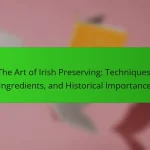Irish desserts are characterized by rich ingredients, traditional flavors, and comforting textures, commonly featuring dairy products, sugar, fresh fruits, and spices. Classic recipes such as bread pudding and apple tart highlight these elements, often served warm for added comfort. The preparation process emphasizes the importance of accurate measurements and following step-by-step instructions to achieve the best results. Presentation techniques focus on visual appeal and cultural elements, utilizing vibrant colors and traditional motifs to enhance the dining experience. This article provides a comprehensive guide on crafting authentic Irish desserts, covering essential recipes, preparation steps, and effective presentation tips.

What are the key elements of Irish desserts?
Irish desserts typically feature rich ingredients, traditional flavors, and comforting textures. Common elements include dairy products like cream and butter, which add richness. Sugar is often used to sweeten desserts, creating a balance with other flavors. Fresh fruits, especially berries, are frequently incorporated for a tart contrast. Traditional spices, such as cinnamon and nutmeg, enhance flavor profiles. Classic desserts like bread pudding and apple tart showcase these elements. Additionally, many Irish desserts are served warm, emphasizing comfort. The use of stout or whiskey in some recipes adds depth and complexity to the flavor.
How do traditional ingredients shape Irish desserts?
Traditional ingredients significantly shape Irish desserts by providing unique flavors and textures. Ingredients like soda bread, Irish cream, and whiskey are commonly used. Soda bread adds a dense, hearty quality to desserts. Irish cream contributes a rich, creamy texture and flavor. Whiskey is often used for its depth and warmth. Additionally, fruits like rhubarb and berries enhance sweetness and tartness. These ingredients reflect Ireland’s agricultural heritage and local culture. The use of these traditional elements creates a distinct identity for Irish desserts.
What are the most common ingredients used in Irish desserts?
The most common ingredients used in Irish desserts include flour, sugar, butter, and eggs. These basic ingredients form the foundation of many traditional recipes. Flour is essential for structure and texture in desserts like soda bread and cakes. Sugar adds sweetness, balancing flavors and enhancing overall taste. Butter provides richness and moisture, crucial for pastries and creamy desserts. Eggs contribute to binding and leavening, helping desserts rise and achieve the desired consistency. Additionally, ingredients like cream, whiskey, and fruits such as berries and apples are frequently incorporated. These elements reflect the simplicity and heartiness characteristic of Irish cuisine.
How do these ingredients influence flavor and texture?
Ingredients in Irish desserts significantly influence both flavor and texture. For instance, ingredients like butter provide richness and a creamy mouthfeel. Sugar contributes sweetness and helps create a tender texture in baked goods. Flour serves as the structural base, affecting density and chewiness. Eggs add moisture and richness, enhancing both flavor and texture. Dairy, such as cream or milk, imparts a smooth texture and can balance sweetness. Spices like cinnamon or nutmeg introduce warmth and complexity to flavors. Each ingredient plays a crucial role in achieving the desired taste and consistency in traditional Irish desserts.
What are some classic Irish dessert recipes?
Classic Irish dessert recipes include Bread and Butter Pudding, Irish Apple Cake, and Baileys Cheesecake. Bread and Butter Pudding is made with layers of buttered bread, raisins, and a custard mixture. It is baked until golden and served warm. Irish Apple Cake features a moist sponge filled with tart apples and is often served with custard. Baileys Cheesecake incorporates the famous Irish cream liqueur into a creamy filling on a biscuit base. These desserts reflect traditional Irish flavors and ingredients, showcasing the country’s culinary heritage.
What is the recipe for Bread and Butter Pudding?
To make Bread and Butter Pudding, you need the following ingredients: 8 slices of stale bread, 4 tablespoons of butter, 4 eggs, 2 cups of milk, 1 cup of sugar, 1 teaspoon of vanilla extract, and a pinch of salt.
First, preheat your oven to 350°F (175°C). Next, butter each slice of bread on one side and cut them in half. Arrange the bread in a buttered baking dish, overlapping the slices.
In a bowl, whisk together the eggs, milk, sugar, vanilla, and salt. Pour this mixture evenly over the bread. Allow it to soak for about 30 minutes.
Bake the pudding for 30 to 40 minutes until the top is golden brown and the custard is set. Let it cool slightly before serving.
This recipe is a traditional way to use leftover bread, making it a popular dish in Irish cuisine.
How is Irish Cream Cheesecake prepared?
To prepare Irish Cream Cheesecake, start by preheating the oven to 325°F (160°C). Next, combine crushed graham crackers, melted butter, and sugar to form the crust. Press this mixture into the bottom of a springform pan and bake for 10 minutes. In a mixing bowl, beat cream cheese until smooth. Gradually add sugar and mix until well combined. Incorporate Irish cream liqueur and vanilla extract into the mixture. Add eggs one at a time, mixing on low speed to avoid overbeating. Pour the cheesecake filling over the cooled crust. Bake for 50 to 60 minutes until the center is set but still slightly jiggly. Let the cheesecake cool at room temperature before chilling in the refrigerator for at least four hours. Finally, serve with whipped cream or chocolate shavings on top for decoration.
What steps are involved in making Apple Tart?
To make an Apple Tart, start by preparing the pastry dough. Combine flour, butter, sugar, and salt in a bowl. Add cold water gradually until the mixture forms a dough. Chill the dough for at least 30 minutes. Next, roll out the dough and fit it into a tart pan. Preheat the oven to 375°F (190°C).
For the filling, peel and slice apples, then toss them with sugar, cinnamon, and lemon juice. Arrange the apple slices in the tart shell. Bake the tart for 30-40 minutes until the apples are tender and the crust is golden brown. Allow it to cool before serving.
Why is presentation important in crafting Irish desserts?
Presentation is important in crafting Irish desserts because it enhances the overall dining experience. A visually appealing dessert attracts attention and stimulates appetite. Presentation can highlight the cultural significance of Irish ingredients and traditional techniques. For example, vibrant colors and thoughtful arrangement can showcase fresh fruits or rich creams. Moreover, well-presented desserts reflect the skill and care put into their creation. Studies show that people often judge food quality based on its appearance. Therefore, a beautiful presentation can elevate a simple dessert into a memorable culinary delight.
What techniques enhance the visual appeal of desserts?
Techniques that enhance the visual appeal of desserts include the use of color, texture, and presentation. Bright colors attract attention and make desserts more enticing. Contrasting colors can highlight specific elements, such as fruit or chocolate. Textural variety adds interest; for instance, pairing smooth frosting with crunchy toppings creates a delightful contrast. The arrangement of components also matters; layering ingredients can create depth and visual intrigue. Garnishes like fresh herbs or edible flowers enhance aesthetics and add a touch of elegance. Finally, using appropriate serving dishes can elevate the overall presentation. These techniques contribute to a more appealing dessert experience.
How can garnishes elevate the presentation of Irish desserts?
Garnishes can significantly enhance the presentation of Irish desserts. They add visual appeal and create an inviting atmosphere. Fresh fruits like berries or citrus slices provide vibrant color contrasts. Edible flowers can introduce elegance and sophistication. Chocolate shavings or drizzles can add a touch of decadence. Whipped cream or custard can create texture and richness. A sprinkle of nuts or spices can add depth and interest. Each garnish choice can reflect traditional Irish flavors, enhancing the overall experience.

How can I effectively prepare Irish desserts?
To effectively prepare Irish desserts, start with traditional recipes like Irish soda bread or bread and butter pudding. Gather fresh ingredients such as flour, butter, sugar, and dairy products. Measure ingredients accurately for the best results. Follow recipe instructions step-by-step to ensure proper technique. Preheat your oven to the specified temperature before baking. Use quality cookware to achieve even cooking. Allow desserts to cool before serving for optimal flavor. Presentation is key; consider garnishing with whipped cream or fresh fruit. These methods ensure authentic and delicious Irish desserts.
What are the essential preparation steps for Irish desserts?
The essential preparation steps for Irish desserts include gathering ingredients, measuring accurately, and following specific recipes. First, select traditional ingredients such as flour, sugar, butter, and dairy. Measure each ingredient precisely to ensure consistency in texture and flavor. Preheat the oven to the required temperature, typically around 350°F (175°C) for most baked goods. Prepare baking pans by greasing or lining them with parchment paper. Mix dry ingredients separately before combining with wet ingredients to achieve a uniform batter. Bake according to the recipe’s specified time and temperature, checking for doneness with a toothpick. Allow desserts to cool before serving or decorating, as this enhances flavor and presentation.
How do I properly measure and mix ingredients?
To properly measure and mix ingredients, use precise measuring tools. For dry ingredients, utilize measuring cups and spoons designed for accuracy. For liquids, employ a liquid measuring cup with clear markings. Always level off dry ingredients with a straight edge for exact measurements. When mixing, start with the dry ingredients before adding wet ones. This ensures even distribution. Use a whisk or mixer to combine thoroughly. Mixing until just combined prevents overworking the batter, which can affect texture. Following these steps leads to consistent results in baking.
What baking techniques are crucial for success?
Crucial baking techniques for success include precise measuring, proper mixing, and temperature control. Precise measuring ensures accurate ingredient ratios, which is essential for chemical reactions in baking. Proper mixing techniques, such as creaming butter and sugar, incorporate air for leavening. Temperature control affects baking time and texture. For example, preheating the oven ensures even cooking. Additionally, understanding the role of gluten development impacts the texture of baked goods. Using the right baking pans also influences the final product. These techniques are foundational for achieving consistent and high-quality results in baking.
What common mistakes should be avoided when preparing Irish desserts?
Common mistakes to avoid when preparing Irish desserts include not using traditional ingredients. Authentic Irish desserts often rely on specific items like Irish butter and cream. Skipping these can alter the flavor profile significantly. Another mistake is overlooking proper measurements. Accurate measurements ensure consistency in texture and taste. Additionally, undercooking or overcooking can ruin the dessert. Each recipe has precise timing that should be followed. Not allowing desserts to cool properly before serving can also affect presentation and taste. Lastly, neglecting to taste and adjust flavors during preparation can lead to unbalanced desserts.
How can I prevent overbaking or underbaking?
To prevent overbaking or underbaking, monitor the baking time closely. Use a reliable timer to track the duration. Check for doneness a few minutes before the recommended time. Insert a toothpick into the center; it should come out clean or with a few crumbs. Ensure your oven temperature is accurate by using an oven thermometer. Avoid opening the oven door frequently, as this can cause temperature fluctuations. Follow the recipe’s instructions carefully for specific baking temperatures and times. Adjust based on your oven’s performance, as ovens can vary significantly.
What tips help ensure the right consistency in batters and fillings?
To ensure the right consistency in batters and fillings, measure ingredients accurately. Use a kitchen scale for precision. Incorporate dry ingredients gradually to avoid clumping. Mix wet ingredients thoroughly before combining them with dry ones. Adjust liquid or flour as needed based on the desired thickness. For fillings, ensure they are cooked to the right temperature to thicken properly. Use a whisk for a smooth texture, avoiding lumps. Allow batters to rest if specified in the recipe to enhance texture. These practices lead to a consistent and desirable outcome in baking.

What are the best tips for presenting Irish desserts?
To present Irish desserts effectively, focus on visual appeal and cultural elements. Use vibrant colors to enhance the dish’s appearance. Incorporate traditional Irish motifs in your presentation, such as Celtic designs. Serve desserts on rustic or wooden platters to evoke a homey feel. Garnish with fresh herbs or edible flowers for added freshness. Consider using glassware to showcase layered desserts, highlighting textures. Pair desserts with complementary sauces or creams artistically drizzled on the plate. Finally, ensure portions are well-balanced to maintain a clean and elegant look.
How can I create an inviting dessert display?
To create an inviting dessert display, arrange desserts in an aesthetically pleasing manner. Use varying heights by incorporating stands or pedestals. This adds visual interest and draws the eye. Choose a color palette that complements the desserts. For example, use pastel colors for a soft look or vibrant hues for a lively display. Incorporate decorative elements like fresh flowers or greenery to enhance the presentation. Ensure good lighting to highlight the desserts, as proper illumination can make them look more appealing. Lastly, label each dessert clearly to inform guests about the offerings. Studies show that well-presented food enhances appetite and enjoyment, making a good display essential.
What types of serving dishes work best for Irish desserts?
Ceramic dishes are ideal for serving Irish desserts. They retain heat well and enhance presentation. Glass dishes are also popular for their elegance. They allow guests to see the dessert layers. Wooden boards can be used for rustic presentations. They add a traditional touch to the table. Individual ramekins are perfect for portion control. They are great for serving desserts like bread pudding. Lastly, metal tins are suitable for baked goods. They provide a classic look for items like apple crumble.
How can I use color and texture to enhance presentation?
Using color and texture can significantly enhance the presentation of Irish desserts. Bright colors attract attention and stimulate appetite. For instance, using vibrant fruits like berries can add visual appeal. Textures create interest; combining creamy elements with crunchy toppings can enhance the eating experience. Contrasting colors can highlight different components of a dessert. For example, a dark chocolate cake can be beautifully complemented by a light-colored whipped cream. Additionally, garnishing with fresh herbs or edible flowers introduces both color and texture. Studies show that visually appealing dishes can increase perceived taste and enjoyment. A well-presented dessert can elevate the overall dining experience.
What finishing touches can improve the overall look of Irish desserts?
Garnishing with fresh herbs like mint enhances the visual appeal of Irish desserts. Adding a dusting of powdered sugar creates a delicate finish. Drizzling chocolate or caramel sauce adds elegance and richness. Using colorful fruits as toppings provides contrast and freshness. Incorporating edible flowers introduces a touch of sophistication. Serving desserts on decorative plates elevates the overall presentation. Utilizing layers in desserts can create visual interest. Finally, careful plating techniques can highlight the textures and colors of the ingredients.
How do I incorporate fresh fruits or sauces as garnishes?
Incorporating fresh fruits or sauces as garnishes enhances the visual appeal and flavor of desserts. Begin by selecting fresh fruits that complement your dessert, such as berries, citrus slices, or stone fruits. Wash and prepare the fruits, cutting them into appropriate sizes for garnish. For sauces, choose flavors that pair well with your dessert, like chocolate, caramel, or fruit coulis. Drizzle the sauce artfully on the plate or over the dessert. Arrange the fruits aesthetically, either on top of the dessert or alongside it. The use of vibrant colors and contrasting textures will make the dish more inviting. Studies show that visually appealing presentations can enhance the perceived taste of food.
What are some creative ways to plate Irish desserts?
Use colorful garnishes to enhance the visual appeal of Irish desserts. Fresh fruits like berries or citrus slices add vibrant colors. Edible flowers can also create a beautiful presentation. Consider using sauces for artistic drizzling on the plate. Chocolate or caramel sauces can provide contrast and add flavor. Layer desserts in clear glasses for a modern look. This showcases the textures and colors of the ingredients. Serve desserts on unique dishware to elevate the experience. Rustic wooden boards or slate plates can complement traditional Irish desserts. Arrange components in a visually appealing manner to draw attention. A well-plated dessert can enhance the dining experience significantly.
What are some practical tips for successfully crafting Irish desserts?
Use high-quality ingredients for Irish desserts. Fresh dairy products enhance flavor and texture. Incorporate traditional Irish elements like whiskey or stout for authenticity. Follow recipes closely for best results. Measure ingredients accurately to ensure consistency. Pay attention to baking times and temperatures. Allow desserts to cool properly before serving. Garnish with fresh fruits or whipped cream for presentation.
Crafting Irish Desserts focuses on the essential elements, preparation steps, and presentation techniques for traditional Irish desserts. The article outlines key ingredients such as flour, sugar, butter, and dairy, which create rich flavors and comforting textures. It details classic recipes like Bread and Butter Pudding, Irish Apple Cake, and Baileys Cheesecake, while emphasizing the importance of presentation and garnishing techniques. Additionally, it provides practical tips for successful baking, ensuring readers can create authentic and visually appealing Irish desserts.


